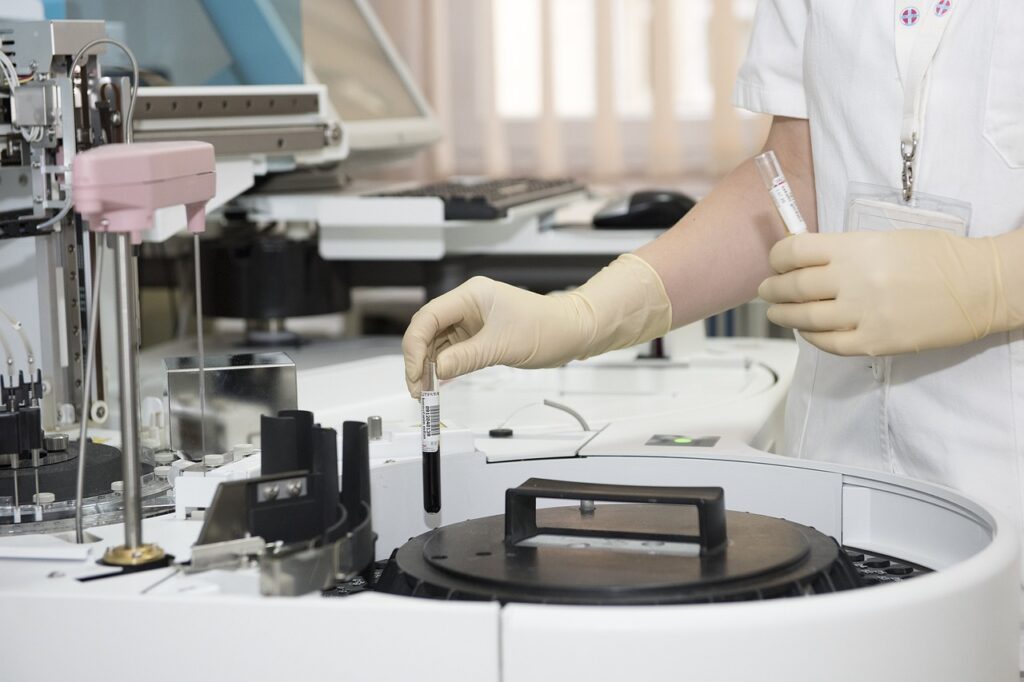pH of a Saturated Solution
This type of problem does not require concentration. We know the Ksp and we know the solution is saturated. This information will be sufficient.
We need to know about Ksp AND acid base ideas to solve this problem type. If we lack one or the other of these skills, just be aware that we might struggle a little in our understanding of this problem type.
To solve the problem, we must first calculate the [OH¯]. To do this, we will use the Ksp expression, and then, at the end, we will use acid-base concepts to get the pH.

Note: Ksp is almost always given at 25.0 °C in reference sources. All problems in this tutorial are assumed to be at 25.0 °C. If you were to see a problem where the specified temperature was different, it’s probably just that the reference source gave a Ksp that, for whatever reason, was not at 25.0 °C.
Example #1:
Calculate the pH of a saturated solution of AgOH, Ksp = 2.0 x 10¯8
Solution:
AgOH ⇌ Ag+ + OH¯
Ksp = [Ag+] [OH¯]
2.0 x 10¯8 = (s) (s)
s = 1.4 x 10¯4 M (this is the [OH¯])
pOH = −log [OH¯] = −log 1.4 x 10¯4 = 3.85
I actually took the negative log of 1.414 . . . x 10¯4; I did not use just 1.4
Because pH + pOH = 14, we have pH = 14 − 3.85 = 10.15
Example #2:
Calculate the pH of a saturated solution of Mg(OH)2, Ksp = 5.61 x 10¯12
Solution:
Mg(OH)2 ⇌ Mg2+ + 2 OH¯
Ksp = [Mg2+] [OH¯]2
5.61 x 10¯12 = (s) (2s)2 = 4s3
After dividing by 4 and then taking the cube root:
s = 1.12 x 10¯4 M
This is an important point: what we have calculated is ‘s’ and it is NOT the [OH¯]. That value is ‘2s.’
[OH¯] = 2.24 x 10¯4 M
pOH = −log 2.24 x 10¯4 = 3.650
pH = 14 − 3.650 = 10.350
Example #3:
Calculate the pH of a saturated solution of Ba(OH)2, Ksp = 5.0 x 10¯3.
Solution:
5.0 x 10¯3 = (s) (2s)2
s = 0.10772 M
2s = [OH¯] = 0.21544 M
pOH = 10¯0.21544 = 0.67
pH = 14 − 0.67 = 13.33
Example #4:
What is the pH in a saturated solution of Al(OH)3? The Ksp of Al(OH)3 is 1.80 x 10¯33. (By the way, there is quite a bit of variance in reported Ksp values for Al(OH)3. I don’t know why that should be so, but I felt it should be mentioned so you wouldn’t feel it necessary to email me and tell me I’m using a wrong Ksp value.)
Solution:
1) Write the Ksp expression for Al(OH)3:
Ksp = [Al3+] [OH¯]3
2) Solve the Ksp expression for the hydroxide concentration:
1.8 x 10¯33 = (s) (3s)3
s = 2.85744 x 10¯9 M
3) Determine the pOH, then the pH:
pOH = −log 2.85744 x 10¯9 = 8.544
pH = 14 − 8.544 = 5.456
4) THIS IS WRONG!! Notice that you added a base (Al(OH)3) to the solution and you obtained an acidic pH. THIS CANNOT BE!!
5) The mistake is that, in this situation, we cannot ignore the hydroxide contribution from the water (which is 1.00 x 10¯7 M). Normally we can, but not in this instance. An approximate answer can be obtained by adding the two hydroxide contributions together:
1.00 x 10¯7 M + 2.85744 x 10¯9 M = 1.0285744 x 10¯7 M
6) Now, do the pOH and the pH:
pOH = −log 1.0285744 x 10¯7 = 6.988
pH = 14 − 6.988 = 7.012
WHOOSH!! That was a close one!!
Example #5:
Calculate the pH of a saturated solution of Cu(OH)2, Ksp = 1.6 x 10¯19
Solution:
1) Write the chemical equation:
Cu(OH)2 ⇌ Cu2+ + 2 OH¯
2) Write the Ksp expression:
Ksp = [Cu2+] [OH¯]2
1.6 x 10¯19 = (s) (2s)2
s = 3.42 x 10¯7 M
3) This is an important point: what we have calculated is ‘s’ and it is NOT the [OH¯]. The value we want is represented by ‘2s.’
[OH¯] = 6.84 x 10¯7 M
pOH = −log 6.84 x 10¯7 = 6.165
pH = 14 − 6.165 = 7.835
4) The natural contribution of hydroxide from water molecules ionizing is 1.00 x 10¯7 M. What is the new pH if we take the hydroxide from water into consideration?
(6.84 x 10¯7 M) + (1.00 x 10¯7 M) = 7.84 x 10¯7 M
pOH = −log 7.84 x 10¯7 = 6.106
pH = 14 − 6.016 = 7.894
5) Adding the two hydroxide amounts only gives a crude estimate. A truer picture would only arise with more complex calculations that are beyond the scope of this website.
The following three examples are all of the form X(OH)2. These are the ones most commonly asked on tests and in worksheets. Calculate the pH of a saturated solution of:
Example #6: Ca(OH)2, Ksp = 7.9 x 10¯6 (pH = 12.10)
Example #7: Mn(OH)2, Ksp = 4.6 x 10¯14 (no answer provided)
Example #8: Ni(OH)2, Ksp = 2.8 x 10¯16 (no answer provided)
It means so much to receive positive feedback and know that my content is appreciated. I strive to bring new ideas and insights to my readers.
Your blog is a true hidden gem on the internet. Your thoughtful analysis and in-depth commentary set you apart from the crowd. Keep up the excellent work!